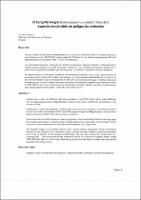Mostrar el registro sencillo del ítem
El Sangrillo Negro (paramachaerium gruberi Brisicky) especie maderable en peligro de extinción.
| dc.contributor.author | Vargas Jimenez, Luis Manuel | |
| dc.date.accessioned | 2019-09-23T15:23:48Z | |
| dc.date.available | 2019-09-23T15:23:48Z | |
| dc.date.issued | 2002 | |
| dc.identifier.uri | http://jadimike.unachi.ac.pa/handle/123456789/128 | |
| dc.description | Panama has a varied and rich flora. The total extension it has (75,517 Km2), And in which 9000 species of angiospermae plants (Magnoliophyta Division) from which 1230 (17,3%) are endemic it is an evidence of this. Panama has a varied and rich flora. Panama has a very varied and rich flora. An evidence of this is the fact that within its total area (75,517 km2) 9000 angiosperm species (Magnoliophyta division) have been recordered. 1,250 (17,3%) of those plants are endemic. Human activities in which forests are clear-cut represent a direct and indirect threat to the huge vegetal richness, particularly, to endemic plants whose extintion may cause either loss of species with an unknown economical potential or that has not been exploted at its large extent. The Sangrillo Negro is an endemic species with a local economic importance whose surviving is threated by the Human Forces. However, its life cycle has not been studied in detail nor estimated how it may be affected by the changes (irregularities). The man has caused in the environment surrounding him. The reasons previously mentioned leaded us to study the Sangrillo Negro during 1985-1990 what allow to check known data and get more new information to make clear some points about this interesting specie. | es_ES |
| dc.description.abstract | Panama has a varied and rich flora. The total extension it has (75,517 Km2), And in which 9000 species of angiospermae plants (Magnoliophyta Division) from which 1230 (17,3%) are endemic it is an evidence of this. Panama has a varied and rich flora. Panama has a very varied and rich flora. An evidence of this is the fact that within its total area (75,517 km2) 9000 angiosperm species (Magnoliophyta division) have been recordered. 1,250 (17,3%) of those plants are endemic. Human activities in which forests are clear-cut represent a direct and indirect threat to the huge vegetal richness, particularly, to endemic plants whose extintion may cause either loss of species with an unknown economical potential or that has not been exploted at its large extent. The Sangrillo Negro is an endemic species with a local economic importance whose surviving is threated by the Human Forces. However, its life cycle has not been studied in detail nor estimated how it may be affected by the changes (irregularities). The man has caused in the environment surrounding him. The reasons previously mentioned leaded us to study the Sangrillo Negro during 1985-1990 what allow to check known data and get more new information to make clear some points about this interesting specie. | es_ES |
| dc.language | spa | |
| dc.language.iso | es | es_ES |
| dc.publisher | NATURA | es_ES |
| dc.relation | none | |
| dc.relation.ispartofseries | NATURA;vol 2/ num 10 | |
| dc.rights | info:eu-repo/semantics/openAccess | |
| dc.rights | info:eu-repo/semantics/openAccess | |
| dc.subject | Sangrillo Negro | es_ES |
| dc.subject | maderable | es_ES |
| dc.subject | peligro de extinción | es_ES |
| dc.subject | paramachaerium gruberi Brisicky | es_ES |
| dc.title | El Sangrillo Negro (paramachaerium gruberi Brisicky) especie maderable en peligro de extinción. | es_ES |
| dc.type | Article | es_ES |
| dc.type | info:eu-repo/semantics/article | |
| dc.type | info:eu-repo/semantics/publishedVersion |
Ficheros en el ítem
Este ítem aparece en la(s) siguiente(s) colección(ones)
-
Artículos Científicos [51]
Artículos publicados en revistas científicas externas

